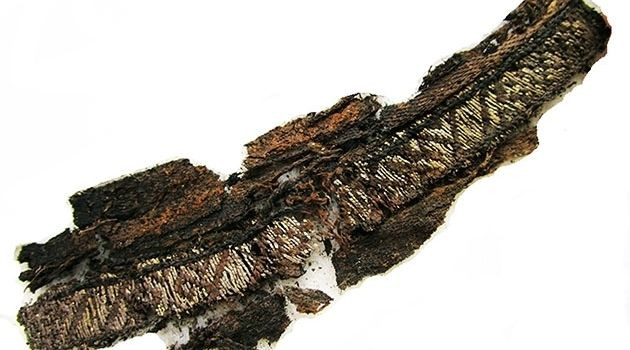Arabic Hidden In Viking Clothes Suggests Islamic Influence On Northern Europe

Researchers have found Arabic script referencing “Allah” hidden in Viking Age artifacts, showing Islam may have had a strong influence on Scandinavian culture hundreds of years ago.
The experts discovered some patterns woven onto clothes people were buried in are geometrically designed characters from the Arabic script called Kufic, Uppsala University announced. They were on silk bands across burial costumes and were found to use the word for God, “Allah,” and the name “Ali,” a relative of the prophet Muhammad and the fourth of the Muslim religious leaders called caliphs who succeeded him. The textiles were connected to human remains from the Viking Age, which ran from the late 8th century to the mid-11th century, that were found in tombs and in boat graves, in which a vessel is used as a burial container.
According to the university, those graves included ones in Birka, an island town that was a cultural and economic hub for Scandinavia during that age. The people who lived in what is now Sweden, Norway and Denmark used Birka as a trading center.
While the deceased could have been Muslim immigrants from places like Persia, the appearance of Arabic script in silver thread on funeral clothes doesn’t necessarily mean the grave occupants were followers of Islam.
“Presumably, Viking Age burial customs were influenced by Islam and the idea of an eternal life in paradise after death,” textile archaeology researcher Annika Larsson said in the Uppsala statement. “Grave goods such as beautiful clothing, finely sewn in exotic fabrics, hardly reflect the deceased’s everyday life, just as little as the formal attire of our era reflects our own daily lives. The rich material of grave goods should rather be seen as tangible expressions of underlying values.”
Scientists are still working to determine the geographic origins of the people.
In the case of burial garments these researchers studied, those underlying values were expressed in a cryptic way.
“One exciting detail is that the word ‘Allah’ is depicted in mirror image,” Larsson said. “Perhaps this was an attempt to write prayers so that they could be read from left to right, but with the Arabic characters they should have.”
These textiles had been discovered decades ago but Larsson only recently re-examined them and uncovered the clues. According to BBC News, she made the connection after noticing similarities between the geometric designs and those seen in Moorish fabrics from Spain.
The woven words may be connected to the type of fabric used in these burial clothes. Many Viking Age graves in Scandinavia incorporated silk burial clothing with Persian and Central Asia roots instead of wool or linen.

“In the Quran, it is written that the inhabitants of paradise will wear garments of silk, which along with the text band’s inscriptions may explain the widespread occurrence of silk in Viking Age graves,” Larsson said. “The findings are equally prevalent in both men’s and women’s graves.”
The new findings are on display at the Enköping Museum, including in Arabic.
Kufic characters have been found in other places during these centuries, such as in mosaics at burial sites in Central Asia.
And BBC News pointed out that a Viking ring found in a ninth-century grave in Birka two years ago was found to have “for Allah” written on it in a type of Arabic script. That ring was discovered in the grave of a woman.
“It is a staggering thought that the bands, just like the costumes, was made west of the Muslim heartland,” Larsson said. “That we so often maintain that eastern objects in Viking Age graves could only be the result of plundering and eastward trade doesn’t hold up as an explanatory model.”
© Copyright IBTimes 2024. All rights reserved.





















